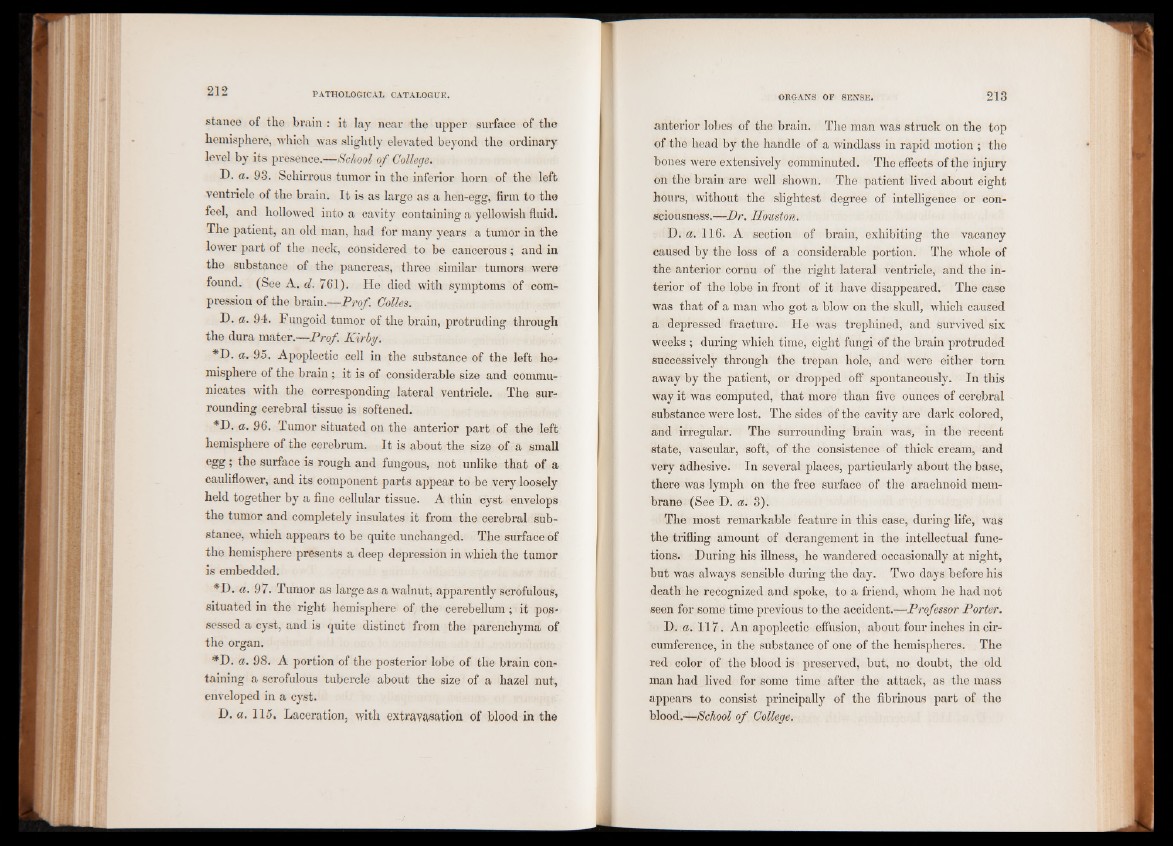
stance of the brain : it lay near the upper surface of the
hemisphere, which was slightly elevated beyond the ordinary
level by its presence.—School of College.
D. a. 93. Schirrous tumor in the inferior horn of the left
ventricle of the brain. It is as large as a hen-egg, firm to the
feel, and hollowed into a cavity containing a yellowish fluid.
The patient, an old man, had for many years a tumor in the
lower part of the neck, considered to be cancerous ; and in
the substance of the pancreas, three similar tumors were
found. (See A. d. 761). He died with symptoms of compression
of the brain.—Prof. Colies.
D. a. 94. Fungoid tumor of the brain, protruding through
the dura mater.—Prof. Kirby.
*D. a. 95. Apoplectic cell in the substance of the left hemisphere
of the brain ; it is of considerable size and communicates
with the corresponding lateral ventricle. The surrounding
cerebral tissue is softened.
*D. a. 96. Tumor situated on the anterior part of the left
hemisphere of the cerebrum. It is about the size of a small
eSS > the surface is rough and fungous, not unlike that of a
cauliflower, and its component parts appear to be very loosely
held together by a fine cellular tissue. A thin cyst envelops
the tumor and completely insulates it from the cerebral substance,
which appears to be quite unchanged. The surface of
the hemisphere presents a deep depression in which the tumor
is embedded.
*D. a. 97. Tumor as large as a walnut, apparently scrofulous,
situated in the right hemisphere of, the cerebellum; it possessed
a cyst, and is quite distinct from the parenchyma of
the organ.
#D. a. 98. A portion of the posterior lobe of the brain containing
a scrofulous tubercle about the size of a hazel nut,
enveloped in a cyst.
D . a. 115. Laceration, with extravasation of blood in the
anterior lobes of the brain. The man was struck on the top
of the head by the handle of a windlass in rapid motion ; the
bones were extensively comminuted. The effects of the injury
on the brain are well shown. The patient lived about eight
hours, without the slightest degree of intelligence or consciousness.—
Dr. Houston.
D. a. 116. A section of brain, exhibiting the vacancy
caused by the loss of a considerable portion. The whole of
the anterior cornu of the right lateral ventricle, and the interior
of the lobe in front of it have disappeared. The case
was that of a man who got a blow on the skull, which caused
a depressed fracture. He was trephined, and survived six
Weeks ; during which time, eight fungi of the brain protruded
successively through the trepan hole, and were either torn
away by the patient, or dropped off spontaneously. In this
way it was computed, that more than five ounces of cerebral
substance were lost. The sides of the cavity are dark colored,
and irregular. The surrounding brain was, in the recent
state, vascular, soft, of the consistence of thick cream, and
very adhesive. In several places, particularly about the base,
there was lymph on the free surface of the arachnoid membrane
(See D. a. 3).
The most remarkable feature in this case, during life, was
the trifling amount of derangement in the intellectual functions.
During his illness, he wandered occasionally at night,
but was always sensible during the day. Two days before his
death he recognized and spoke, to a friend, whom he had not
seen for some time previous to the accident.—Professor Porter.
D. a. 117. An apoplectic effusion, about four inches in circumference,
in the substance of one of the hemispheres. The
red color of the blood is preserved, but, no doubt, the old
man had lived for some time after the attack, as the mass
appears to consist principally of the fibrinous part of the
blood.—School of College.